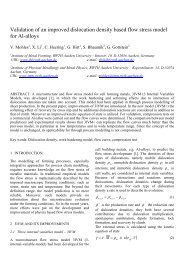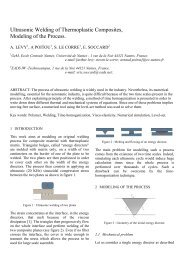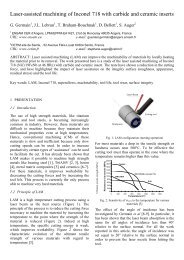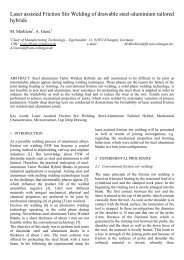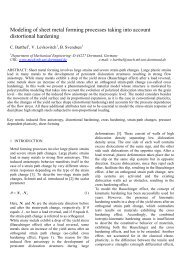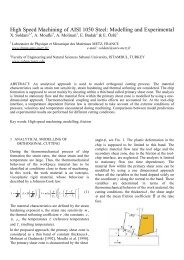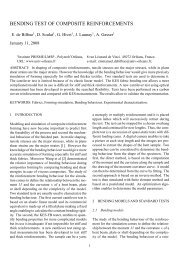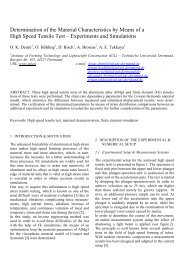Here - the ESAFORM 2008 Conference - INSA de Lyon
Here - the ESAFORM 2008 Conference - INSA de Lyon
Here - the ESAFORM 2008 Conference - INSA de Lyon
Create successful ePaper yourself
Turn your PDF publications into a flip-book with our unique Google optimized e-Paper software.
should be compared. That is <strong>the</strong> inner diameter of<strong>the</strong> <strong>de</strong>formed ring specimen.Comparing <strong>the</strong> volumes of a ring before and after<strong>the</strong> FE simulation showed that <strong>the</strong> loss in volumewas approximately equal to 0.5%. As a result, it isuseless to control <strong>the</strong> outer diameter before and aftereach simulation trial. That is why <strong>the</strong> inner diameteris only controlled.The <strong>de</strong>termined values of <strong>the</strong> friction factor k n aregiven in Table 3. Figures 2 and 3 show <strong>the</strong>relationships between <strong>the</strong> friction factors and <strong>the</strong>temperatures for <strong>the</strong> lubricants un<strong>de</strong>r study.Moreover, in Table 3 <strong>the</strong> value of friction factortaken from [5] are given. These data correspond to<strong>the</strong> upsetting of rings ma<strong>de</strong> from <strong>the</strong> same Al-alloyswith <strong>the</strong> help of hydraulic press. The <strong>de</strong>formationprocess was iso<strong>the</strong>rmal in those tests. It means that<strong>the</strong> initial temperature of a specimen and tools wasequal to each o<strong>the</strong>r. The initial strain rate was0.14 s -1 .Table 3. Friction actors k n valuesFriction factor k nT, °C Strain rate, s -10.14 s –1 28.6 s –1 0.14 s –1 28.6 s –1A95456 A95456 A92618 A92618IO+G200 0.171 0.41 0.25 0.21350 0.153 0.287 0.236 0.202430 0.155 0.245 0.146 0.179450 0.118 0.216 0.15 0.17470 0.11 0.21 0.138 0.143SO+G200 0.245 0.45 0.19 0.34350 0.206 0.396 0.223 0.32430 0.15 0.37 0.143 0.26450 0.12 0.31 0.114 0.24470 0.143 0.285 0.133 0.235Figures 2 and 3 illustrate <strong>the</strong> effect of twoparameters on friction factor, i.e. temperature andinitial strain rate. It can be seen that <strong>the</strong> moretemperature of <strong>de</strong>formation, <strong>the</strong> less friction factorvalue is. It is valid for both investigated alloys.On <strong>the</strong> o<strong>the</strong>r hand, using two different presses interms of <strong>the</strong>ir <strong>de</strong>sign allowed to investigate <strong>the</strong>effect of strain rate on friction factor value.Unfortunately, we could not perform thiscomparison within <strong>the</strong> whole range of investigatedtemperatures. The reason for that is linked to <strong>the</strong> factthat <strong>the</strong> conditions of <strong>de</strong>formation in each casesdiffered from each o<strong>the</strong>r. In case of using of <strong>the</strong>screw press for <strong>de</strong>formation <strong>the</strong> iso<strong>the</strong>rmal conditionwas approximately observed at <strong>the</strong> temperature of200°C.Taking it into consi<strong>de</strong>ration it can be conclu<strong>de</strong>d thatat temperature of 200°C <strong>the</strong> effect of strain rate ismore significant for Al-Mg alloy. Moreover, it isin<strong>de</strong>pen<strong>de</strong>nt from <strong>the</strong> lubricant’s composition.Increasing <strong>the</strong> strain rate from 0.14 to 28.6 s -1 givesrise to increase in friction factor in over two times. Itis valid for both lubricants.Fig. 2. Deformation of A92618 alloy: solid and dash lines –regression; points - experimentFig. 3. Deformation of A95456 alloy: solid and dash lines –regression; points - experimentOn <strong>the</strong> o<strong>the</strong>r hand, for Al-Cu-Mg-Fe-Ni alloy <strong>the</strong>effect of strain rate on friction factor value is not soobvious. For <strong>the</strong> lubricant based on syn<strong>the</strong>tic oil(SO+G) <strong>the</strong> influence of initial strain rate on k n isalmost <strong>the</strong> same. The increase in friction factor valueis over 1.5 times. For IO+G lubricant <strong>the</strong> effect ofstrain rate is opposite to it. The difference between<strong>the</strong> values of friction factor for both initial values ofstrain rate is inessential.4.2 Regression for friction factor vs temperatureThe temperature <strong>de</strong>pen<strong>de</strong>nce of <strong>the</strong> friction factor



